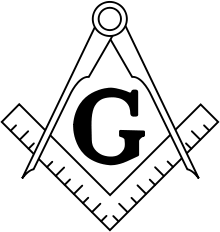Provincial Grand Master
| Part of a series on |
| Freemasonry |
|---|
 |
|
History
|
|
Masonic bodies
|
|
Views of Masonry |
|
People and places
|
Provincial Grand Master (abbreviated PGM or PrGM), sometimes called District Grand Master or Metropolitan Grand Master, is an office held by the senior Freemason in the middle management layer of masonic administration, between the national and the local levels. Similar terms are also used in some other fraternal organisations.
Freemasonry
History of the Office
Freemasonry's first Grand Lodge was formed in London in 1717 by four private Lodges meeting in that city; all of the first private lodges warranted by it were within easy communicating distance of London.[1] As lodges became more distant an intermediate level of administration became necessary.[2] The very first Provincial[3] Grand Master was appointed for Cheshire in 1725.[4] There are currently 47 Masonic Provinces in England and Wales under the original 1717 Grand Lodge, now known as the United Grand Lodge of England.[5]
Worldwide use
This intermediate level of administration is not restricted to England & Wales. There are Provinces (with Provincial Grand Masters) under the Grand Lodge of Ireland,[6] the National Grand Lodge of France,[7] and the Grand Lodge of Scotland,[8] for example. However, not all Masonic jurisdictions have Provinces or Provincial Grand Masters.
Alternative titles
Under the United Grand Lodge of England, three terms now exist for this intermediate level of administration. In the counties of England and Wales there are Provinces, each headed by a Provincial Grand Master. In overseas territories controlled (masonically) from London (mostly in the states of the former British Empire) the equivalent unit is called a District, headed by a District Grand Master. Since 2002 the facility has also existed to create an equivalent layer of administration and management in any urban conglomeration, to be known as a Metropolitan Area, and headed by a Metropolitan Grand Master. The only such Metropolitan Area so far created is that of London, although potentially a similar Metropolitan Area could be created in any large English or Welsh urban zone, such as Birmingham or Manchester. Similarly, the Grand Lodge of Ireland has a Metropolitan Area of Dublin, and the Grand Lodge of Scotland has Provinces at home, but Districts overseas. All Provincial Grand Masters, District Grand Masters, and Metropolitan Grand Masters hold a patent of appointment from their nation's Grand Master, by which he delegates to them the authority to govern his private lodges within their respective Province, District, or Metropolitan Area.
Women Freemasons
Generally speaking, Orders of women Freemasons use identical rituals, titles, and regalia to their male counterparts. Thus the foregoing applies (with local variation) to female masonic Grand Lodges worldwide.
Non-masonic bodies
The same offices are also found historically within the Orange Order, a Protestant organization which has close similarities to Freemasonry in terms of regalia and symbolism,[9] both in Northern Ireland where it began,[10] and overseas.[11]
A later organization, which in part mimics the hierarchical structure of the Masons, is the Oddfellows. In the Manchester Unity (a leading branch of the organisation) a Provincial Grand Master[12] holds an office between local Lodge and National level.
Other fraternal organizations such as the Buffaloes, while retaining the Central Committee/Intermediate Strat/Lodge structure, use equivalent terms such as Provincial Grand Primo.[13]
See also
References
- ↑ Encyclopædia Britannica 1955 Vol 9 p736 "Freemasonry" Hughan, W.J. Senior Grand Deacon of Freemasons 1874
- ↑ Explanation of Necessity
- ↑ that is belonging to a county district p1216 Chambers Dictionary (2003, Edinburgh, Chambers Harrap) ISBN 0-550-10105-5
- ↑ A short history of Freemasonry in Cheshire Taylor, H. ; Lawson, P.H. (1925 Chester, Provincial grand Lodge of Cheshire) p17
- ↑ Province details, England & Wales.
- ↑ Province details, Ireland.
- ↑ Province details, France.
- ↑ Province details, Scotland.
- ↑ The Old Firm Murray,B.(1984,rev;2000 Edinburgh John Donald Publishers)pp62-63 ISBN 0-85976-542-3
- ↑ Historical reference to the office
- ↑ Canadian origins
- ↑ Odd Fellow Officers
- ↑ RAOB structure